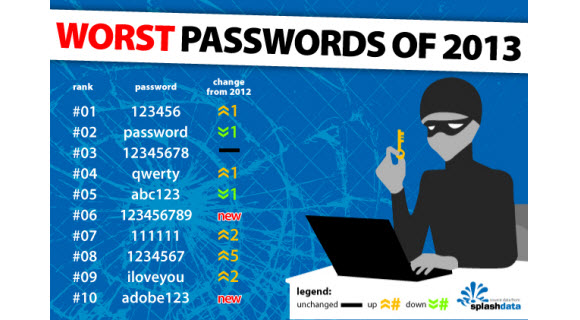Managing passwords for a growing list of websites can be a chore. Especially when you take the time to create strong passwords for each site. It might seem like work but trust me it’s worth it. As demonstrated by the Adobe hack which exposed millions of user accounts. I know a lot of people use the same password for every site or go with a common word or memorable date. Unfortunately that just isn’t good enough anymore.

The image above shows a list of the top 10 worst passwords of 2013 as compiled by SplashData. They used the data exposed in the Adobe hack which explains why adobe123 made the top 10 list. You’ll notice the ever popular “password” and new #1 bad passcode “123456” in the list. As you can see the list includes very simple words or numbers. It would be very easy to figure out any of these passwords and you can bet those who want access to your accounts know all the tricks. Here’s a full list of the top 25 worst passwords of 2013:
- 123456
- password
- 12345678
- qwerty
- abc123
- 123456789
- 111111
- 1234567
- iloveyou
- adobe123
- 123123
- admin
- 1234567890
- letmein
- photoshop
- 1234
- monkey
- shadow
- sunshine
- 12345
- password1
- princess
- azerty
- trustno1
- 000000
Help Creating Strong Passwords
Not that we’ve presented some bad passwords let’s take a look at some tips for creating strong alternatives. It really comes down to how secure you want them to be. You could always use a site or software tool to create a series of random passwords. If you go that route we suggest Norton’s password generator. This site is free to use. You can set the following options:
- Password length – we recommend at least 8 characters
- Include letters
- Include mixed case
- Include numbers
- Include punctuation
- No similar characters
Choose your parameters and then select the number of passwords you want generated. The site will handle up to 50 at one time. From there we suggest you find a good password safe to keep your account information. There are several available. I’ve personally used Password Safe and Keepass over the years. Both are good solutions.
Here are a few suggestions for those who would rather create their own passwords:
- Minimum length of eight characters
- Use upper and lower case letters
- Include numbers
- Mix in a special character
Try not to use a common word with some letters replaced by numbers or special characters. I promoise it won’t take long for someone to hack something like Pa$$w0rd. You can use phrases to help. Turning something like “My dog looks more like a horse” into mD1m!Ah. That would work for a single account but trying to do it across lots of sites can get pretty tough. I find it much easier to use a password locker to store all the details.
I hope you found the guide helpful. Strong passwords are a great start to protecting yourself online. I also recommend a good VPN services. These companies help protect your identity by changing your IP address and encrypting your online data. You can learn more about them and other privacy companies by reading some of our VPN reviews. If you have any questions please feel free to contact us through the site or via Twitter – @VPNSP.



